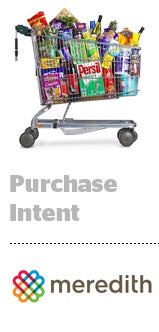 Intent data for a hotel might look very different than it does for a shampoo manufacturer.
Intent data for a hotel might look very different than it does for a shampoo manufacturer.
Whereas luxury and travel marketers have direct access to transaction data that can be used to target and upsell customers, CPG manufacturers often sell at the SKU level through retailers, which retain the purchase data.
CPG advertisers need granular data on specific product purchases to target against audience intent. Meredith Corp., the largest food media network in the US, is striving to help CPG manufacturers fill the gap with data from its more than 80 million unique visitors.
“When it comes down to it, data is only as good as the specificity, granularity and scale that it offers,” said Chip Schenck, VP of data and programmatic at Meredith. “Different businesses require different levels. When you sell something that might have hundreds of thousands, if not millions, of SKUs, it’s not effective to just understand which stores a consumer goes into.”
Meredith makes intent data valuable to CPG manufacturers in four areas: food, parenting, home and women, the last of which touches on lifestyle, beauty, health and wellness. In general, manufacturers in these categories sell through supermarkets, drugstores or other retailers.
Meredith helps CPGs target consumer intent by monitoring the content a user is consuming, the action he or she takes in response to that content and the time of day it occurs.
For example, if a consumer is looking at 10 chicken recipes on AllRecipes.com and adds one to her shopping cart, Meredith knows from the browsing history that she is likely to buy chicken that day. Company research shows that 50% of AllRecipes.com readers are in a store within 24 hours of searching, Schenck said.
Meredith can then match consumers’ intent-driven action against first-party data that gives insight into user shopping patterns, such as which days of the week they typically hit the supermarket.
“Having hundreds of thousands of recipes and 1 billion visits on just one site, we start to see significant scale in terms of ingredients, meal time and food patterns from a trend and usage perspective, but also timing,” Schenck said.
Meredith identifies and targets time-centric behaviors through a suite of data and shopper marketing tools.
Mobile is a huge proxy for in-store targeting. On AllRecipes.com, for example, mobile browsing indicates that a consumer is using the recipe as a shopping list in-store. The advertiser can leverage that to put messaging in a recipe that directly correlates with its ingredients.
“It’s not just, ‘This recipe calls for peanut butter.’ It’s, ‘Jiffy is 50% off at Target,’” Schenck said.
Meredith expands its intent-targeting capabilities by layering in data from its other core verticals to cross-promote products to relevant audiences.
“When we combine food interests with data that this [person] is a mom with children under 2 years old, that’s a huge opportunity for Kimberly-Clark to sell diapers,” Schenck said.
The level of granularity CPG manufacturers require to forecast intent can make it difficult to predict purchasing patterns at scale. But Meredith’s ability to draw corollaries between different verticals helps marketers access a wide range of consumers.
Advertisers partner with Meredith to access data through its ad server or direct private marketplace deals. The media company’s internal knowledge of its user base helps marketers better understand things like who their shoppers are and what products are trending.
Meredith uses the Krux data management platform to collect PII data to create anonymized segments for its 80 million monthly unique visitors. It is also used to onboard offline data to match known and unknown users across Meredith’s properties.
Updated to correct Meredith unique user count.














